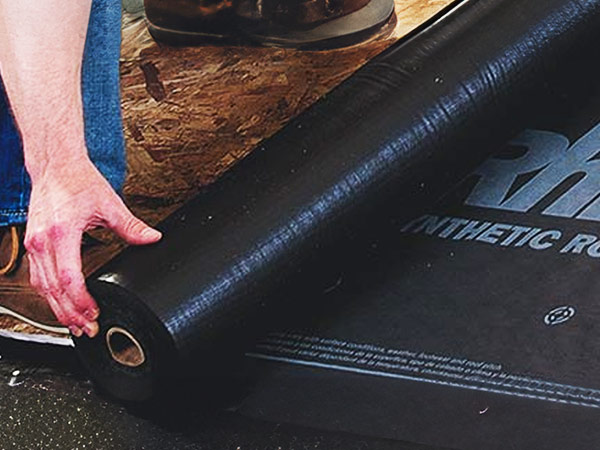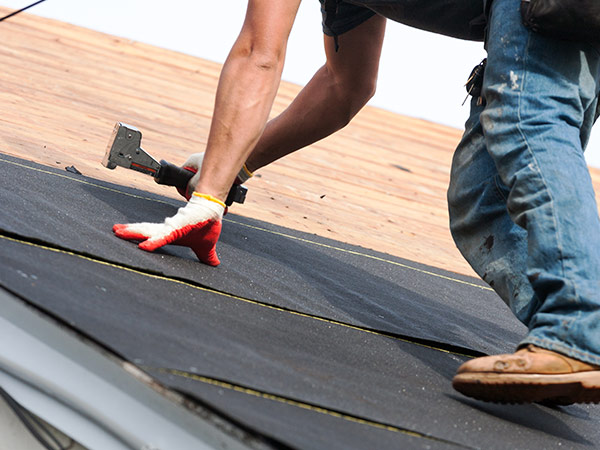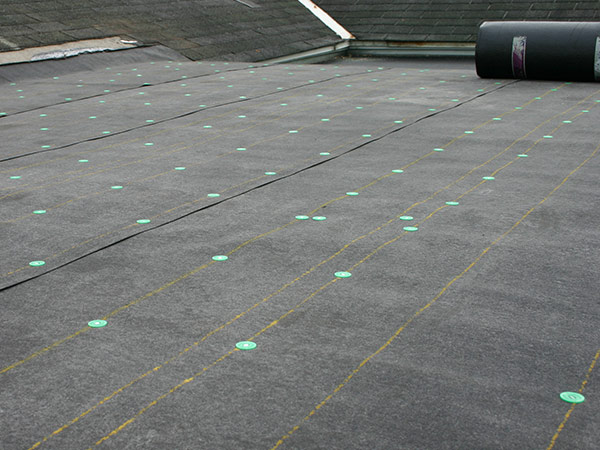

Nothing But the Roof: Roofing Underlayment Choices Are Vital
As a roofer, you know roofing underlayment provides a protection barrier to keep the roof deck dry. However, it can be hard to decide if asphalt, felt, or synthetic underlayment should be used. Here’s our guide to the different types of roofing underlayment to help you create the best possible roof for your customers.
Felt Roofing Underlayment
Felt roofing (sometimes called roofing felt) is typically made from natural materials such as wood pulp soaked with a protective asphalt layer (also known as bitumen) that gives it water-shedding properties. If a shingle blows off during a wind storm or becomes damaged from physical damage, the underlayment will help prevent water from getting inside the home.
Options for felt underlayment include 15lb and 30lb weight per hundred square feet. A 15lb roofing felt would be a good choice where the total roof weight is a concern. The 30lb option is a good heavy-duty project choice, where you need something more tear- and wear-resistant, such as under slate or tile shingles.
Other felt roofing underlayment considerations include:
- Roofing felt is affordable, providing a good budget option for nearly any project.
- Don’t skip the underlayment! It may be necessary to maintain Class A fire requirements for the shingles. Since shingles are evaluated with tests where roofing felt underlayment is used, it should also be included in roof construction. (Check the underlayment product labels for ASTM International details.)
- Felt underlayment can tear, especially lighter weight 15lb. roofing felt.
- It can also absorb moisture, causing wrinkles to form during installation. This can create a challenging surface on which to lay flat shingles.
- It can produce excess weight on the structure’s roof, especially 30lb. roofing felt, which can be applied in one or two layers.
- When laying down roofing felt, the surface can become slippery. This in turn can make installation difficult.
- Because felt is a heavy material, felt roofing underlayment come in shorter rolls that are easier to handle, but this will also add labor time and effort to install them on a roof.

Synthetic Roofing Underlayment

A more modern option is a synthetic underlayment. This option is typically manufactured from long-lasting polymers such as polypropylene or polyethylene. It’s been praised for its durability – even holding up to exposure to ultraviolet (UV) rays and moisture.
Synthetic roofing underlayment is tougher than its felt predecessor, and is thinner and easier to work with, making it less effort to install. This can save installation time as well as simple effort since the lighter synthetic rolls also come in longer lengths than felt.
This new product also is moisture-resistant, but not slippery, meaning a safer surface that has improved walkability for your roofing crew.
But these benefits also come with a cost – quite literally. For projects with a small budget, synthetic material may be the wrong choice since it’s more expensive than felt underlay. Synthetic material may not be compliant with some building codes. If the rooftop doesn’t have ventilation, synthetic underlayment may not be a good option, since it acts as a vapor barrier.

Rubberized Asphalt

A common choice for low-slope or low-pitched roofs is asphalt or “rubberized asphalt” underlayment. Typically manufactured with adhesive on one side, this product is also sometimes referred to as “self-sealing” or “peel-and-stick.”
The benefits of asphalt underpayments include their ability to seal well around staples and nails and their heat resistance. They can be longer-lasting than felt underlay (up to 50 years), which means fewer replacements. And they can create a more relaxed installation process, due to the fact they can be left exposed to the elements – great if a construction delay is possible.
Asphalt underlayment can also be manufactured for specific benefits, such as some with added polyethylene or polyester to create a non-skid surface. Or they may be reinforced for increased durability with added fiberglass. They also could have a mineral or polymer film bonded to the weather-exposed surface to increase durability in a range of climates. They even can be used under metal roofing materials and some resist temperatures up to 250 degrees F.
But there are also downsides to asphalt underlay. Because of the nature of the adhesive is to remain stuck to the roofing deck, replacing the roof involves taking up the decking as well. The rolls tend to be heavier than felt, increasing labor for hauling materials. Asphalt underlayment also comes with a higher price tag compared to felt alternatives.

How to Choose the Best Roofing Materials

There are many reasons to select one roofing material over another, and they don’t always start and end with your budget.
- Climate: Do you require underlayment that will be exposed to high temperatures or lots of moisture during construction or throughout its lifetime?
- Water resistance: How much rain will fall on this roof, and what kind of risks are you willing to take with the chances for leaks?
- Durability: Not only when your crew is installing the roof, but what kind of damage might (literally) fall on this roof after construction? Is debris a possibility or an inevitability?
- Top roof layer material: If the roof shingles will be slate or tile, you have limited choices for underlayment. But if you’re going a bit bare on a low-slope roof, the answer could also be clear. A steep roof that can’t take the weight will also need to be considered.
- Cost: The project budget almost always gets the last word on the subject.
McCoy’s Can Help You with Roofing Choices, and More
Not only will picking the best roof underlayment for the job give you the best roof possible but make you the neighborhood’s go-to for a beautiful, durable, and affordable roof. At McCoy’s we’re about making our customers (and their customers) happy. Do you need advice or tools for your roofing business? We’ve got you (and the roof) covered in our Pro Roofer Center.
